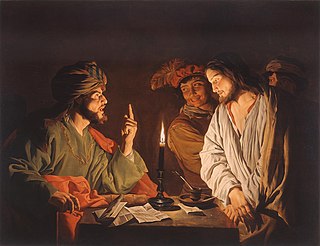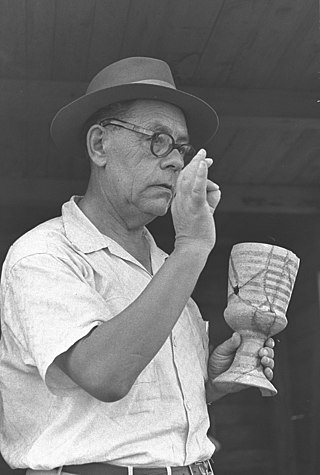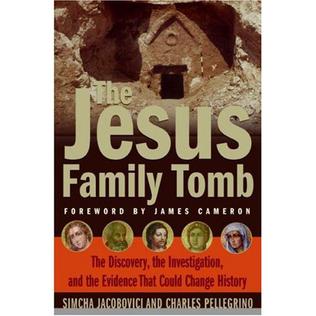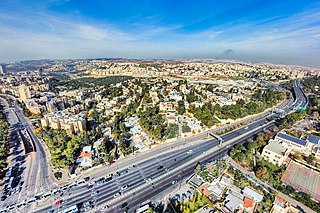Related Research Articles
Yeshua was a common alternative form of the name Yehoshua in later books of the Hebrew Bible and among Jews of the Second Temple period. The name corresponds to the Greek spelling Iesous (Ἰησοῦς), from which, through the Latin IESVS/Iesus, comes the English spelling Jesus.

An ossuary is a chest, box, building, well, or site made to serve as the final resting place of human skeletal remains. They are frequently used where burial space is scarce. A body is first buried in a temporary grave, then after some years the skeletal remains are removed and placed in an ossuary. The greatly reduced space taken up by an ossuary means that it is possible to store the remains of many more people in a single tomb than possible in coffins. The practice is sometimes known as grave recycling.

The James Ossuary is a 1st-century limestone box that was used for containing the bones of the dead. An Aramaic inscription meaning "Jacob (James), son of Joseph, brother of Jesus" is cut into one side of the box. The ossuary attracted scholarly attention due to its apparent association with the Christian holy family.

Joseph ben Caiaphas, known simply as Caiaphas in the New Testament, was the Jewish high priest during the years of Jesus' ministry, according to Josephus. The Gospels of Matthew, Luke and John indicate he was an organizer of the plot to kill Jesus. He famously presided over the Sanhedrin trial of Jesus. The primary sources for Caiaphas' life are the New Testament, and the writings of Josephus. The latter records he was made high priest by the Roman procurator Valerius Gratus after Simon ben Camithus had been deposed.

Theophilus was the High Priest in the Second Temple in Jerusalem from 37 to 41 CE according to Josephus's Antiquities of the Jews. He was a member of one of the wealthiest and most influential Jewish families in Iudaea Province during the 1st century. A growing but still uncommon belief points to High Priest Theophilus as the person to whom the Gospel of Luke is addressed, but Theophilus is a common enough name that there are many other possibilities for the addressee of Luke's Gospel and the Acts of the Apostles. In its favor is the fact that in Luke Theophilus is called by the title Most Excellent (kratiste), indicating he held a political office like high priest, the ethnarch under the Romans. In Acts 1:1 he does not have this honorific indicating that he no longer held an office of the Roman government. This provides an unusual identifier that eliminates other candidates for whom such a change in office was not effected.
The Paleo-Hebrew script, also Palaeo-Hebrew, Proto-Hebrew or Old Hebrew, is the writing system found in inscriptions of Canaanite languages from the region of Southern Canaan, also known as biblical Israel and Judah. It is considered to be the script used to record the original texts of the Hebrew Bible due to its similarity to the Samaritan script, as the Talmud stated that the Hebrew ancient script was still used by the Samaritans. The Talmud described it as the "Libona'a script", translated by some as "Lebanon script". Use of the term "Paleo-Hebrew alphabet" is due to a 1954 suggestion by Solomon Birnbaum, who argued that "[t]o apply the term Phoenician [from Northern Canaan, today's Lebanon] to the script of the Hebrews [from Southern Canaan, today's Israel-Palestine] is hardly suitable". The Paleo-Hebrew and Phoenician alphabets are two slight regional variants of the same script.

Eleazar Lipa Sukenik was an Israeli archaeologist and professor at the Hebrew University of Jerusalem. He is best known for helping establish the Department of Archaeology at the Hebrew University and being one of the first academics to recognise the age and importance of the Dead Sea Scrolls. He also oversaw the uncovering of the Third Wall of ancient Jerusalem. He also was the director of the Museum of Jewish Antiquities at the Hebrew University.

Momine Khatun Mausoleum is a mausoleum, also known as the Atabek Dome, located in the city of Nakhchivan of the Nakhchivan Autonomous Republic in Azerbaijan. It was built in 1186 by the architect Ajami ibn Abubekr Nakhchivani. The ten-sided mausoleum reached a height of 34 meters. Today its height is only 25 meters. The mausoleum, built and named after the mother of one of the local rulers of Azerbaijan, Atabek Jahan Pahlavan of Ildegezid dynasty, is masterfully decorated with complex geometric ornaments and inscriptions from Koran.

The Talpiot Tomb is a rock-cut tomb discovered in 1980 in the East Talpiot neighborhood, five kilometers south of the Old City in East Jerusalem. It contained ten ossuaries, six inscribed with epigraphs, including one interpreted as "Yeshua bar Yehosef", though the inscription is partially illegible, and its translation and interpretation is widely disputed. The tomb also yielded various human remains and several carvings.

The Lost Tomb of Jesus is a pseudoarchaeological docudrama co-produced and first broadcast on the Discovery Channel and Vision TV in Canada on March 4, 2007, covering the discovery of the Talpiot Tomb. It was directed by Canadian documentary and film maker Simcha Jacobovici and produced by Felix Golubev and Ric Esther Bienstock, while James Cameron served as executive producer. The film was released in conjunction with a book about the same subject, The Jesus Family Tomb, issued in late February 2007 and co-authored by Jacobovici and Charles R. Pellegrino. The documentary and the book's claims have been rejected by the overwhelming majority of leading experts within the archaeological and theological fields, as well as among linguistic and biblical scholars.

The Jesus Family Tomb: The Discovery, the Investigation, and the Evidence That Could Change History (ISBN 0061192023) is a controversial book by Simcha Jacobovici and Charles R. Pellegrino published in February 2007. It tells the story of the discovery of the Talpiot Tomb on Friday March 28, 1980 and makes an argument that it is the tomb of Jesus Christ and his family.

Ronny Reich is an Israeli archaeologist, excavator and scholar of the ancient remains of Jerusalem.

Givat HaMivtar is an Israeli settlement and a neighborhood in East Jerusalem established in 1970 between Ramat Eshkol and French Hill. It is located on a hill where an important battle took place in the Six Day War. Archaeological excavations have revealed important ancient Jewish tombs in the region. Givat Hamivtar was one of the first "Build Your Own Home" neighborhoods in Jerusalem.

The Caiaphas ossuary is one of twelve ossuaries or bone boxes, discovered in a burial cave in south Jerusalem in November 1990, two of which featured the name "Caiaphas".

The Cave of Nicanor is an ancient burial cave located on Mount Scopus in Jerusalem. Among the ossuaries discovered in the cave is one with an inscription referring to "Nicanor the door maker". The cave is located in the National Botanic Garden of Israel on the grounds of the Mount Scopus campus of the Hebrew University of Jerusalem.
Levi Yizhaq Rahmani was an Israeli archeologist and Chief Curator of Israel Antiquities Authority, and notable for his work on tombs, ossuaries and ossilegia in the Second Temple period. Ossuaries are generally catalogued as "Rahmani no. 9", etc., following the numbering in Rahmani's 1994 catalogue.

Peace forest is a forest in South - Southeast Jerusalem, Israel, between the Abu Tor neighbourhood and the Sherover Promenade.

The Houmuwu ding, formerly called Simuwu ding, is a rectangular bronze ding of the ancient Chinese Shang dynasty. It is the heaviest piece of bronzeware to survive from anywhere in the ancient world. It was unearthed in 1939 in Wuguan Village, Anyang, Henan, near Yinxu, the site of the last Shang dynasty capital.
Jonathan, also referred to as Jonathan the High Priest, was a first-century Jewish high priest and religious leader. Shortly after he was announced High Priest of Israel, he was killed in AD 58 by Antonius Felix, the Roman procurator of the province Judea. He was stabbed by robbers hired by Felix with daggers at the Temple.
References
- ↑ "Israeli authorities: 2,000-year-old burial box is the real deal". CNN. 30 June 2011. Retrieved 26 August 2011.
- ↑ Zissu, Boaz; Goren, Yuval (2011). "The Ossuary of 'Miriam Daughter of Yeshua Son of Caiaphas, Priests [of] Maʿaziah from Beth ʾImri'" (PDF). Israel Exploration Journal. 61 (1): 74–95. JSTOR 23214223.
- ↑ The Ossuary of 'Miriam daughter of Yeshua Son of Caiaphas, Priests of Ma'aziah from Beth Imri'